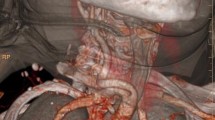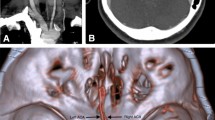Abstract
The anatomical variations of internal carotid artery (ICA) are mostly asymptomatic, thus being disregarded and only incidentally diagnosed, with very few symptomatic patients. The awareness of these anomalies is crucial to solve the differential with other neck lesions, preventing accidental injuries during neck surgery. Therefore, the aim of our study is to estimate the prevalence of ICA anomalies, using magnetic resonance angiography (MRA) and computed tomography angiography (CTA). 253 patients underwent head and neck MRA and CTA examinations, with multiplanar and volumetric reformations. For each set of images, the following items were investigated: origin, development, course, persistence of embryonic vessels and anomalous origin of collateral branches. In our series, ICA arose from the bifurcation of the common carotid artery at the level of: C4 in 303 hemi-necks (59.9 %); C3 in 98 hemi-necks (19.3 %); C5 in 57 hemi-necks (11.3 %); C2 in 48 hemi-necks (9.5 %). ICA kinking and/or coiling was found in 105 hemi-necks, and location variation of ICA (reversed-type) in two hemi-necks. In just one case the origin of the ascending pharyngeal artery was from ICA (0.2 %), while an anomalous persistence of the proatlantal artery was noticed in three cases (0.6 %). CTA and MRA showed similar accuracy in detecting ICA anomalies.




Similar content being viewed by others
References
Altmann F (1947) Anomalies of the internal carotid artery and its branches; their embryological and comparative anatomical significance; report of a new case of persistent stapedial artery in man. Laryngoscope 57(5):313–339
Sasaki T, Nagashima H, Oya F (2013) Carotid artery stenting for atherosclerotic stenosis associated with non-bifurcating cervical carotid artery. Neurol Med Chir (Tokyo) 53(4):228–232
Yu C, Xiong JQ, Dai CP (2013) Independent risk factors for morphological abnormalities of the internal carotid artery. Acta Cardiol 68(5):481–487
Cappabianca S, Scuotto A, Iaselli F, Pignatelli di Spinazzola N, Urraro F, Sarti G, Montemarano M, Grassi R, Rotondo A (2012) Computed tomography and magnetic resonance angiography in the evaluation of aberrant origin of the external carotid artery branches. Surg Radiol Anat 34:393–399
Cirillo M, Scomazzoni F, Cirillo L et al (2013) Comparison of 3D TOF-MRA and 3D CE-MRA at 3T for imaging of intracranial aneurysms. Eur J Radiol 82(12):853–859
Metz H, Murray-Leslie RM, Bannister RG, Bull JWD, Marshall J (1961) Kinking of the internal carotid artery in relation to cerebrovascular disease. Lancet 1:1424–1426
Pfeiffer J, Ridder GJ (2008) A clinical classification system for aberrant internal carotid arteries. Laryngoscope 118:1931–1936
Gerodinsky M, Holyokc EA (1938) The fascial and fascial spaces of the head and neck. Am J Anat 63:367–408
Perdue GD, Barreca JP, Smith RB, King OW (1975) The significance of elongation and angulation of carotid artery: a negative view. Surgery 77:45–52
Godin MS, Rice JC, Kerstein MD (1988) Tortuosity of the right common carotid artery simulating aneurysm. S Med J 81:1382–1385
Mukherjee D, Inahara T (1985) Management of the tortuous internal carotid artery. Am J Surg 149:651–655
Muñoz A, Campollo J, Vergas J (2001) Bilateral internal carotid aneurysms presenting as a nonpulsatile parapharyngeal mass: complementary diagnosis by CT, MR Imaging, and digital subtraction angiography. Am J Neurorad 22:864–866
Schenk P, Temmel A, Trattnig S, Kainberger F (1996) Current aspects in diagnosis and therapy of carotid artery kinking. HNO 44:178–185
Kelly AB (1925) Tortuosity of the internal carotid artery in relation with the pharynx. J Laryngol Otol 40:15–23
Vega J, Gervas C, Vega-Hazas G, Barrera C, Biurun C (1999) Internal carotid artery transposition: another cause of widening of the retropharyngeal space. Eur Radiol 9:347–348
Curtin HD (1996) The larynx. In: Som PM, Curtin HD (eds) Head and neck imaging. Mosby Yearbook, St. Louis, pp 612–707
Paulsen F, Tillman B, Christoforodis C et al (2000) Curving and looping of the internal carotid artery in relation to the pharynx: frequency, embryology and clinical implications. J Anat 197:373–381
Weibel J, Fields WS (1965) Tortuosity, coiling, and kinking of the internal carotid artery. I. Etiology and radiographic anatomy. Neurology 15:7–18
Shanley DJ (1992) Bilateral aberrant cervical internal carotid arteries. Neuroradiology 35:55–56
Gray H (1966) Gray’s anatomy. Lea & Febiger, Philadelphia
McNamara JR, Fulton GJ, Manning BJ (2015) Three-dimensional computed tomographic reconstruction of the carotid artery: identifying high bifurcation. Eur J Vasc Endovasc Surg 49(2):147–153
Gluncic V, Petanjek Z, Marusic A, Gluncic I (2001) High bifurcation of common carotid artery, anomalous origin of ascending pharyngeal artery and anomalous origin of ascending pharyngeal artery and anomalous branching pattern of external carotid artery. Surg Radiol Anat 23:123–125
Ballotta E, Da Giau G, Renon L, Narne S, Saladini M et al (1999) Cranial and cervical nerve injuries after carotid endarterectomy: a prospective study. Surgery 125:85–91
Zumre O, Salbacak A, Cicekcibasi AE, Tuncer I, Seker M (2005) Investigation of the bifurcation level of the common carotid artery and variations of the branches of the external carotid artery in human fetuses. Ann Anat 187(4):361–369
Hacein-Bey L, Daniels DJ, Ulmer JL, Leighton PM, Smith M, Strottmann JM, Brown D, Meyer GA, Wackym PA (2002) The ascending pharyngeal artery: branches anastomoses and clinical significance. Am J Neurorad 23:1246–1256
Basekim CC, Silit E, Mutlu H, Pekkafali MZ, Ozturk E, Kizillkaya E (2004) Type I proatlantal artery with bilateral absence of the external carotid artery. Am J Neurorad 25:1619–1621
Cappabianca S, Del Vecchio W, Giudice A, Colella G (2006) Vascular malformations of the tongue: MRI findings on three cases. Dentomaxillofac Radiol 35(3):205–208
Lell M, Tomandl BF, Anders K, Baum U, Nkenke E (2005) Computed tomography angiography versus digital subtraction angiography in vascular mapping for planning of microsurgical reconstruction of the mandible. Eur Radiol 15(8):1514–1520
Author information
Authors and Affiliations
Corresponding author
Ethics declarations
Conflict of interest
All actions performed in realizing this paper comply with the current laws. The authors declare that they have no conflict of interest.
Rights and permissions
About this article
Cite this article
Cappabianca, S., Somma, F., Negro, A. et al. Extracranial internal carotid artery: anatomical variations in asymptomatic patients. Surg Radiol Anat 38, 893–902 (2016). https://doi.org/10.1007/s00276-016-1652-7
Received:
Accepted:
Published:
Issue Date:
DOI: https://doi.org/10.1007/s00276-016-1652-7




